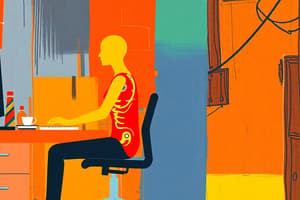Podcast
Questions and Answers
Maintaining a heel-toe gait pattern is essential for efficient walking.
Maintaining a heel-toe gait pattern is essential for efficient walking.
True (A)
The use of one’s body to produce motion that is safe, energy conserving, and anatomically and physiologically efficient is known as proper body mechanics.
The use of one’s body to produce motion that is safe, energy conserving, and anatomically and physiologically efficient is known as proper body mechanics.
True (A)
Proper body mechanics only reduces the stress and strain to muscles, but not joints and ligaments.
Proper body mechanics only reduces the stress and strain to muscles, but not joints and ligaments.
False (B)
Rolling, pushing, pulling, or sliding an object is not recommended when lifting.
Rolling, pushing, pulling, or sliding an object is not recommended when lifting.
Positioning yourself close to the object to be moved is not important for proper body mechanics.
Positioning yourself close to the object to be moved is not important for proper body mechanics.
Mentally planning the lift is not necessary for proper body mechanics.
Mentally planning the lift is not necessary for proper body mechanics.
Widening your base of support during lifting activities is unnecessary.
Widening your base of support during lifting activities is unnecessary.
Keeping the lumbar curve in your lower back while lifting is not important.
Keeping the lumbar curve in your lower back while lifting is not important.
Stoop lifting is not recommended for objects below the level of your hips.
Stoop lifting is not recommended for objects below the level of your hips.
Proper body mechanics has no effect on respiratory and cardiopulmonary function.
Proper body mechanics has no effect on respiratory and cardiopulmonary function.
Flashcards are hidden until you start studying




